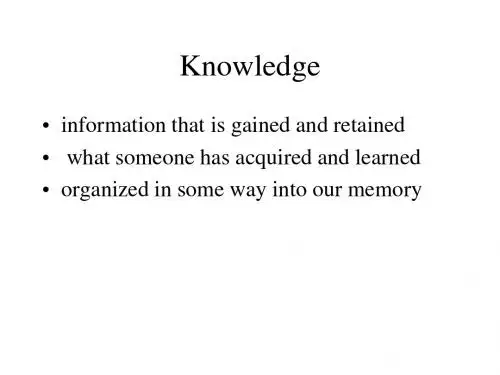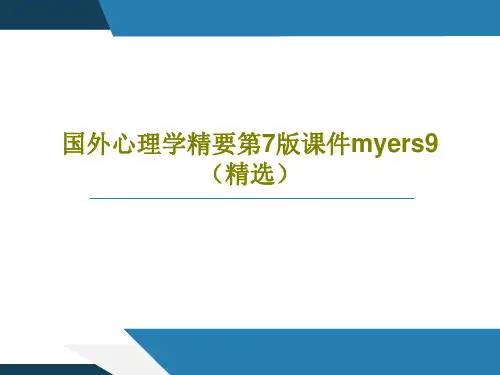国外心理语言学课件9精编版
- 格式:ppt
- 大小:1.86 MB
- 文档页数:23
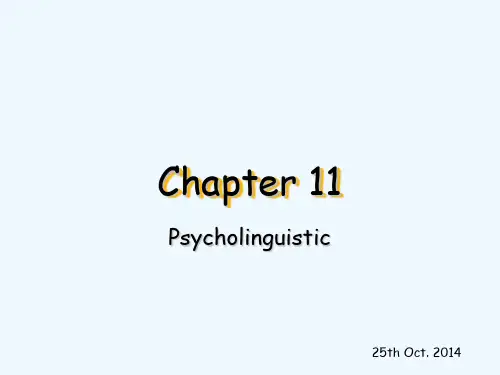

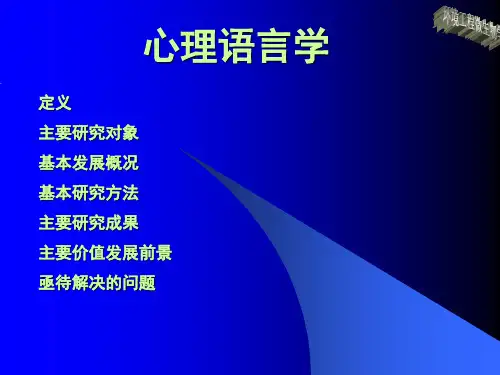
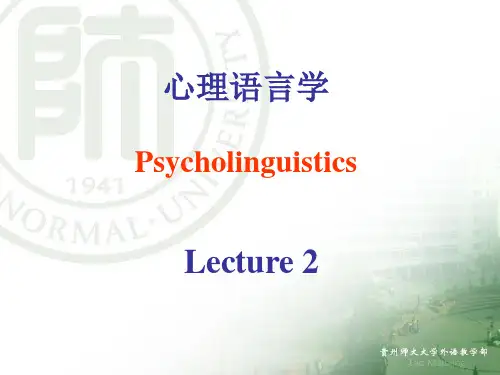
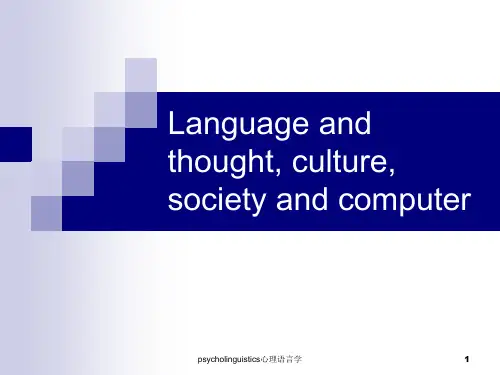

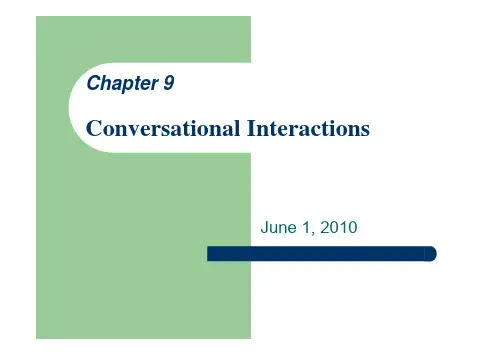
Chapter 9Conversational InteractionsJune 1, 2010Speech production in its social context: conversation1.Lisa:Hey eva there’s something I wanted to tell you.2.Eva: mhm.3.Lisa:My brother is coming to town for a visit next week4.Eva: How nice5.Lisa:and you know, he broke up with that awful Julie “last”week6.Eva: ‘how”very nice, when’s he getting here?7.Lisa:next Monday8.Eva: Want to go shopping and help me pick out something reallyattractive before Monday?Speech production in its social context: conversationFeatures of conversationl Personnel:Participants in a conversationØSpeaker(s) and addressee(s)l Common ground: Knowledge and beliefs shared by the personnelØAssumptions about what the other(s) know(s)/ believe(s)l Action sequence: Small joint projects in a conversation ØOpening, information exchange, closingFeatures of conversationl Adjacency pair:each person contributes something to a joint project.–Agenda setting–Question-and-answer sequencel Contribution:Mutual agreement among the personnel that the addressee has understood the speaker→continue to the next joint project.What is a conversation?n Loosely structured coordinated action. Speech production in its social context.n Coordinated by conventions and negotiationØOpeningØClosingØTurn-takingØTopic selectionØParticipant determinationConversational Interactionn Conversation is a complex process of language use and a special form of social interaction with its own rules and dynamics.n Conversation is a joint action: two participants jointly follow the rules.n Conversation rules: with powerful influence of social and cultural context.Conversation as a speech eventOpening conversationsn Direct addressØHey, George!n Information request ØDo you know the time? n Offer assistanceØAre you looking forsomeone?n Stereotyped expression ØHello!ØExcuse me.n Stereotyped topicØNice weather, huh?ØCome here often?We have only a limited number of ways to open a conversation.Closing conversationsWe use preclosing statement to signal a readiness to end the conversation.n Preclosing statement:ØSooo…ØWell…(can be accepted or not)n Content summary:ØSo, we’re agreed: You’ll hide the body and I’ll distract the cops.n Justifying ending:ØI’m late for a meeting.ØI know you are busy-I’ll let you go now.Closing conversations n Expressing pleasure:ØThis was fun.n Planning future contact:ØSee you later.ØWe’ll divvy up the money on Tuesday.n Wishing well:ØTake care.ØSweet dreams.Turn-takingl One speaker at a time, but there is often overlap at the beginning and ends of turns.l Nonverbal behavior also facilitates an orderly transition from one speaker to another. (Turn-yielding signals)(1) Drop in pitch(2) Drop in loudness(3) Extension of the final syllable(4) Termination of hand gestures(5) Stereotyped expressions (you know)(6) Completion of a grammatical clauseWhat determines who speaks next? Turn taking follows three implicit rules (Sacks, et al., 1974)(1) Current speaker selects the next speaker(2) Self-selection(3) Current speaker continuesTopic selectionl Topics in conversation can be defined in terms of the intersection (overlap) of propositions across sentences.l Created through the selection of individual responsesØA: John bought a red car in Baltimore yesterday.bought (John, car); red (car); in (John, Baltimore); etc.B: I think a red car would be ugly.think (I, X); red (car); X=ugly (car)Topic selectionB: He’s not going to buy my car?ØNew Topic: sellingØA’s options(1) Respond directly –No, he didn’t like it.(2) Refer back to part of initial statement that got a response–He needed it in a hurry.(3) Give general response –It’s always tough to buy a newcar.l Multi-layer structureØCan temporarily shift to meta-layer (outside the standard conversational context)l Correcting grammar, telling jokes, storiesParticipant determination l Participants:–Speaker–Addressee–Side participantsl Additional listeners–Bystanders–EavesdroppersConversational Participantsl Common ground: shared understanding of those involved in the conversation.–Some of the common grounds is culturally based,such as cultural values, commonly held beliefs.–Other types of common ground are more personal.Friends vs. AcquaintancesPlanalp(1993):l Friends were more likely to–use profanity–laugh more often–express negative judgments–argue with one another–make joint references to themselves (we, us)l Acquaintances were more likely to use filled pauses and talk about only one topic.Friends vs. Acquaintances l Friends have (Homstein, 1985)ØImplicit openings•Hi, it’s me.ØMore common ground•Less overt explanationØMore profanityØMore jokesØMore overt negative judgmentsØMore topicsØAsk more questionsGender differencesDo rules hold equally well for mixed-genderconversations and same-gender conversations?l Zimmerman & West (1975)ØOverlapl simultaneous speech during last word of speaker’s turn(trying to get the next turn)ØInterruptionl simultaneous speech before last word of the speaker’s turn(violation of speaker’s turn)ØMinimal responsel supportive remark (e.g., uh-huh); display of interest rather thana violationGender differencesFindings:l96% of the interruptions were by male speakers.l Many of the responses by males to female topics were delayed minimal responses.l Men deny equal status to women as conversational partners with respect to the rights to the full utilization of their turns and support for the development of topics.Gender differencesl Mixed-gender conversationsØMen interrupt much more than women.ØMany delayed minimal responses by men.l Same-gender conversationsØFewer interruptions than in mixed-gender cases.ØSame interruption rate for women & menØFewer delayed minimal responsesl Parent-child conversations are similar to mixed-gender ØMany more interruptions by parentsGender differencesl Lakoff(1975)ØTag questionsl It’s kind of chilly, isn’t it?l She ate the whole pizza, didn’t she?ØHedgesl Sort ofl I guessØQuestion intonations in declarative sentences l So we will meet at 8.All more common for women than menGender differencesGender differencesGender differencel Differences in the expectations imposed on men and women result in gender-based differences inconversational style.–Men tend not to ask questions that make them appear unknowledgeable.–Women tend to use more expressive terms.–Men are more likely to interrupt.–Women tend to use a more collaborative style.Gender difference 找点空闲找点时间领着孩子常回家看看带上笑容带上祝愿陪同爱人常回家看看妈妈准备了一些唠叨爸爸张罗了一桌好饭生活的烦恼跟妈妈说说工作的事情向爸爸谈谈常回家看看回家看看哪怕帮妈妈刷刷筷子洗洗碗老人不图儿女为家做多大贡献呀一辈子不容易就图个团团圆圆常回家看看回家看看哪怕给爸爸捶捶后背揉揉肩老人不图儿女为家做多大贡献呀一辈子总操心只奔个平平安安Power differencesProblems with this kind of researchWhere do Indirect Speech Acts come from?Basic ideas of Politeness Theoryl Politeness theory is the theory that accounts for the redressing of the affronts to face posed by face-threatening acts to addressees. First formulated in 1978 by PenelopeBrown and Stephen Levinson, politeness theory has sinceexpanded academia’s perception of politeness.l Politeness is the expression of the speakers’intention to mitigate face threats carried by certain face threatening acts toward another (Mills, 2003, p. 6). Another definition is "abattery of social skills whose goal is to ensure everyone feels affirmed in a social interaction". Being polite therefore consists of attempting to save face for another.Stephen Levinsonl Research focus: language diversity and its implications for theories ofhuman cognition.l Language is the only animalcommunication system that differsradically in form and meaningacross social groups of the samespecies, a fact that has beenneglected in the cognitive sciences.His work attempts both to graspwhat this diversity is all about, andto exploit it as a way of discovering the role that language plays in oureveryday cognition.l Stephen C. Levinson is director of the Language and Cognition group at the Max Planck Institute for Psycholinguistics in Nijmegen, TheNetherlands. He received a BA in Archaeology and SocialAnthropology from the University of Cambridge and received a PhD in Linguistic Anthropology from the University of California Berkeley. He has held posts at the University of Cambridge, Stanford University and the Australian National University.l His most influential publication is probably Politeness: Universals in Language Usage which he co-authored with Penelope Brown andwhich was a seminal work in Politeness theory.l He has written extensively on pragmatics, and in particular, furthered the work of Paul Grice on conversational implicature. He describes his theories as being 'under the Gricean umbrella'.Basic ideas of Politeness TheoryBasic ideas of Politeness TheorySome simple ways to be politel Always leave the addressee an outØCan you reach the salt?l Give deference and debase selfØThese papers come from my notes of what I read. So I’m afraid that it would be an absolutely meaningless and unnecessary jobfor you to read these bulky papers. You might think it a waste oftime. I ask you not to bother yourself with these and just regardthem as traces of my work.(Conveys the absurdity of coercing compliance)l Explicitly acknowledge indebtedness and apologize.Some simple ways to be polite l Soften the requestØI sort of feel that I must tell you …ØGive me a hand if you can / when you have the time. l Indicate understanding of the size of imposition ØI wouldn’t ask you if I had any other options.How polite do you have to be?l Three factors determine the level of politeness(the amount of effort you have to put into satisfying the face desires of the addressee)(1) Relative social status of speaker and addresseel You and me(2) Amount of solidarity between the speaker and addresseel ASL and Hebrew(3) Size or risk of impositionl Can I have the salt?l Can I have your car?Have to be just polite enoughl Don’t want to undershootØGive me a letter of recommendation.l Don’t want to overshootØI’m sorry for asking and I wouldn’t do this if there was any other way, but do you have the time?。


